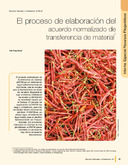| dc.contributor.author | Eng Siang, Lim | |
| dc.date.accessioned | 2019-08-30T17:01:07Z | |
| dc.date.available | 2019-08-30T17:01:07Z | |
| dc.date.issued | 2008-04 | |
| dc.identifier.issn | ISSN: 1659-1216 | ISSN |
| dc.identifier.uri | https://repositorio.catie.ac.cr/handle/11554/9173 | |
| dc.description | 7 páginas, ilustrado. | |
| dc.description.abstract | El acuerdo normalizado de transferencia de mate rial (ANTM) es el contrato que se utilizará para
todo intercambio de materiales dentro del sistema
multilateral de acceso y distribución de benefi cios del Tratado Internacional sobre los Recursos
Fitogenéticos para la Alimentación y la Agricultura. El
ANTM establece las condiciones legales aplicables
tanto a los proveedores como a los receptores de
materiales procedentes del sistema multilateral, así
como los procedimientos para la solución de con troversias. El hecho de que deba aplicarse a toda
transferencia hace del ANTM el instrumento más
importante para el funcionamiento del sistema mul tilateral. El proceso de elaboración del ANTM duró
dos años e incluyó dos reuniones de la Comisión
de Recursos Genéticos de la FAO actuando como
Comité Interino para el Tratado, una reunión de un
Grupo de Expertos, dos de un Grupo de Contacto,
una del Grupo de Amigos del Presidente del Grupo
de Contacto y algunas reuniones informales, antes
de ser adoptado por el Órgano Rector del Tratado
en su primera sesión. En este trabajo se analiza
este proceso de elaboración y se presentan los
asuntos más polémicos con los que debieron lidiar
los negociadores. | |
| dc.description.abstract | The process of developing the standard material
transfer agreement. The standard material transfer
agreement (SMTA) is a contract that will be used
for all transfers of materials under the multilat eral system of access and benefit sharing of the
International Treaty on Plant Genetic Resources for
Food and Agriculture (the Treaty). The SMTA sets
out the legal conditions that apply to both suppli ers and recipients, and establishes procedures for
dispute resolution. Since it will apply to all transfers,
the SMTA will be the most important instrument in
the day-to-day operation of the multilateral sys tem. The process of developing the SMTA lasted
two years and included two meetings of the FAO
Commission on Genetic Resources acting as the
Interim Committee of the Treaty, a meeting of an
Expert Group, two meetings of a Contact Group,
a meeting of a Friends of the Chair Group and
several informal meetings before it was adopted by
the Governing Body of the Treaty at its first session.
This paper explains this process of negotiations
and presents the most controversial issues the
negotiators needed to deal with and agree upon | |
| dc.format.mimetype | pdf | |
| dc.language.iso | es | es_ES |
| dc.publisher | CATIE, Turrialba (Costa Rica) | es_ES |
| dc.publisher | CATIE, Turrialba (Costa Rica) | |
| dc.relation.ispartof | Recursos Naturales y Ambiente Número 53 (Abril 2008), páginas 39-45 | |
| dc.rights | info:eu-repo/semantics/openAccess | es_ES |
| dc.rights | info:eu-repo/semantics/openAccess | |
| dc.rights.uri | https://creativecommons.org/licenses/by-nc-nd/4.0/ | |
| dc.subject | RECURSOS GENETICOS | |
| dc.subject | CONSERVACION DE LOS RECURSOS | |
| dc.subject | LEGISLACION | |
| dc.subject | ACUERDOS INTERNACIONALES | |
| dc.subject | CONSERVACION | |
| dc.subject | CONSERVACION DE LA NATURALEZA | |
| dc.subject | CONSERVACION BIOLOGICA | |
| dc.title | El proceso de elaboración del acuerdo normalizado de transferencia de material | es_ES |
| dc.type | Artículo | es_ES |
| dc.journal.issueNumber | 53 | |
| dc.journal.pages | 39-45 | |



